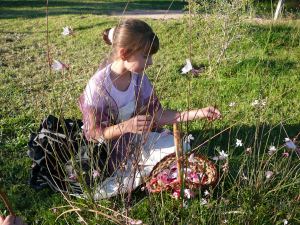A post from my archives ~ To form meaningful connections with your children, it helps to focus especially on the two ‘book ends’ of your day – the waking moments and the bedtime moments. In this post I share some ideas and tips I found useful in seasons of our homeschooling lives.

Bedtimes are a good time to build relationships, deepen our understanding of each other and to even cover some of the reading in our homeschool schedule. Here’s some of our bedtime activities ~
- Read alouds at bedtime – Often this was with just one child, but in the seasons where my daughters shared a room, they would both listen to the story before sleeping. I usually read their fiction books in our curriculum at bedtime. Night-time story time helped me keep our school time shorter in the mornings. Bedtime stories also sometimes helped me catch up if there were interruptions during the day. Read alouds are our homeschool glue and often saved our days! We read books when all else failed. We loved reading any story. It didn’t have to be a book from the school schedule. Sometimes we read an inspirational missionary story or spiritual book. Regularly reading good stories built a love for reading and a love for words, language, story-telling and imagination in our family.
- Reviews and oral narrations – Narrations or telling-back is a very natural way for a child to relate what they understood and remembered from the read alouds. At bedtime, lying cuddled together in bed, my daughters seemed so relaxed and thoughtful, and they could easily tell me what they learnt from the read aloud. Charlotte Mason’s narrations are power-packed with skills and narrations are a fabulous way to witness your child’s learning.
- Best and Worst moments – Nighttime reflection is a wonderful way to connect with your child’s experiences through the day. It is a good time to listen to their happy moments, their joys, their delights, as well as their fears, hurts and disappointments. I reflected back what they just told me by saying what they said in my own words, without commenting, e.g. “You really loved playing at the pond today…” Or I acknowledged their feelings without judgement, saying, “You must have felt really mad when …” which helped them feel that I hear and understood them. It is a very important way to validate and empathize with your children., building strong, trusting relationships.
- Pray together – Night time prayers flow so easily from #3 “Best and Worst Moments“, praising and thanking the Lord for all the best and praying over the worst. Teach your child to be thankful. Thankfulness and gratitude are powerful resources to motivation and health. Teach your child how to forgive others, to ask for forgiveness and to receive forgiveness. Dealing with challenging circumstances, difficulties, challenges, or repeated failures is very hard for a child. Praying together over any of these issues helps your child roll the burden onto the Lord, to learn to trust Him and to know that your child is not working through these things alone.
- Affirm and encourage – Bedtime is one of the best times to affirm and encourage your child. Focus on building up your child with positive affirmations and genuine, focused acknowledgements of your child’s character, personality and her importance to you and others. Again, relationships are key, but this is also a good time to acknowledge where your child did something well, accomplished something challenging or coped with some difficulty. Long after the lights are out, as your child lingers in the dark, falling asleep, these words penetrate deeply and are the final thoughts for the day.
- Ideas for the next day – Talk about the upcoming events, or meetings with others, or dentist appointments, etc. at night gave my child the time to prepare emotionally. I found this very helpful, especially for my more anxious child. Sometimes we would talk about how a meeting with so-and-so would go, imagining and talking about how to handle the situation. Sometimes using humor made these discussions funny and gave a different perspective to something my child felt anxious about. It was a good time to gently discuss my expectations about my child’s behaviour, being very positive and encouraging.
- Bedtime notebooks – Once your child can write, we enjoyed private and very special notebooks which we would slip under each other’s pillows at night. I treasure their deeply personal letters. They often shared things we could not speak about. This is really valuable when children reach their tweens and teen years.
My children really valued these special night-time moments together with me, and there were times where dad took over their bedtime routine and his bedtimes with the kids was very different from mine. He often was louder, funnier and their bedtimes activities were often far more physical. They often spent their time with dad doing tickles, wrestles, pillow fights and jokes. They loved him reading funny stories, usually with sound effects, and they would eventually go to sleep, happy and exhausted, which was a win for me!
What special moments do you have with your children? Please share with us in the comments below.
Trusting your family has very blessed bedtimes.
In Grace, Nadene























You must be logged in to post a comment.